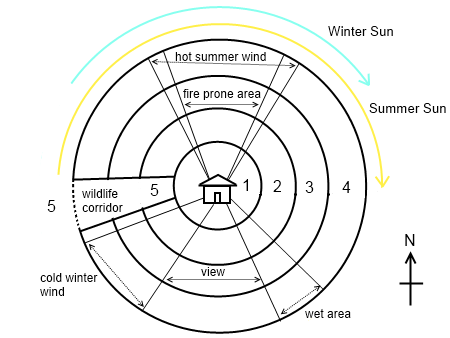In this, and the subsequent posts I would like to revisit and complete the discussion of the Permaculture principles I started three years ago.
Applying Natural Patterns in our Designs
As I've mentioned, probably in writing about each of these design principles, the aim of permaculture is creating and managing diverse ecosystems with numerous connections between species. But the big question that remains, is how to go about it. Since there are so many individual factors, you could even say that each site has its own uniqueness, so no matter what the answer is, it will have to be as general as possible, or else be filled with "but only if", "provided that", and "except for".
So before we get lost in details, let's take a step back and try to see the forest from all the trees. In a sense, this is exactly what this principle is trying to express. Complex systems, like the one we are trying to build, evolve from simple ones, following certain patterns that are maintained into complexity. It is therefor most important to select the most appropriate pattern, and fill in the details with time, as the offer themselves.
Developing Pattern Literacy
David Holmgren points out that especially in our high-tech world our natural sense for seeing natural pattern has been turned upside down, making it a bit of a challenge to become pattern literate. Also, for developments outside of our scale we may simply lack the vision. This is why we have no problem building our homes on the flood plain of a river that is immersed under water every 30-50 years. Once we begin getting a feel for it, however, we'll start recognizing them everywhere around us. It starts with such simple things as waking up in the morning and going to bed at night, or looking at the cyclical pattern of the changing seasons. A story is usually structured in familiar patterns, and music follows clearly recognizable patterns.
Patterns in Nature
Some of the pattern you can find in nature repeat themselves on various levels, from the human scale down to the cellular, the molecular, the atomic and subatomic, as well as up to the global, celestial, galactic, etc. One of the most easily recognizable pattern is the spiral, observable in the shape of galaxies, movement of clouds, the growth pattern of plants, or the double-helix of our DNA.
Another common one is the wave, whether on the ocean or sand dunes. Sound and light also travel in wave forms, as well as electrical impulses. The so called overbeck jet pattern is what can be seen in the form of a mushroom, a jellyfish, a nuclear explosion, or the shape of water when a drop hits its surface.
Branching patterns are very common, from the way a tree spreads its branches, to how water flows together forming streams and rivers. The same can be observable in our blood vessel, and also the shape of lightning. A vortex is similar to a spiral, but on the three dimensional level, observable in tornadoes, or the way water flows down a drain. Depending on many factors, smoke rising from a fire can take up a vortex or an overbeck jet pattern.
Finally, tesselation is the pattern of many surfaces, such as the scales on reptiles, the eyes of an insect, or the hexagons in a honeycomb. Oftentimes nature combines various patterns in one, such as tesselation and branching in the structure of many leaves, or spirals and waves in the shape of many clouds. At this point I should probably also mention sacred geometry, such as Fibonacci series and the Golden Ratio. Since this would open up another long discussion, I just want to leave them standing here. For those who know what I'm talking about, it should ring a bell. For everyone else, I urge you to look into it!
Using Patterns on the Homestead: Zones and Sectors
Applying pattern thinking to our permaculture sites, we should ultimately take such things in consideration, where the sun comes from, and how it changes throughout the year, where the wind tends to blow from, and which way water flows. Another aspect is how frequently you visit each area of the site. indicating all these factors on a site map, you will ultimately end up with zones and sectors.
Zones are concentric circles (though in practice they are rarely circular), with zone 1 being immediately outside your home, containing your highly frequented kitchen garden. Further out, zones 2 to 4 include orchards, pastures, and forests, which you visit less frequently the further away it is. Zone 5 is generally reserved for nature, which you may visit merely for observation on rare occasions.
Sectors indicate how certain energies affect your site from various directions. This could include summer and winter sun, a wind sector for prevalent winds, a view sector, a fire sector, wildlife, noise, people, or whichever other types of things you identify that affects your space.
Gradual Development
Just like with so many things, learning pattern literacy is a step-by-step process (in itself a pattern). The more we do it, the better we become at noticing them. Then we can incorporate them into our designs, and as we go along we can revisit them, see how well they have worked, and modify them accordingly.
Sources: 1, 2, 3 Pics: 1, 2, 3, 4, 5
To see my discussions of other Permaculture Principles, take a look at these posts:
Permaculture: A Starting Point
David Holmgren
- Observe and interact
- Catch and store energy
- Obtain a yield
- Apply self-regulation and accept feedback
- Use and value renewable resources and services
- Produce no waste
- Design from patterns to details
- Integrate rather than segregate
- Use small and slow solutions
- Use and value diversity
- Use edges and value the marginal
- Creatively use and respond to change
Bill Mollison
- Work with nature, not against it
- The problem is the solution
- Maximum effect for minimum effort
- The yield of the system is theoretically unlimited
- Everything gardens





Congratulations @stortebeker! You have completed the following achievement on the Hive blockchain and have been rewarded with new badge(s) :
You can view your badges on your board And compare to others on the Ranking
If you no longer want to receive notifications, reply to this comment with the word
STOPDo not miss the last post from @hivebuzz:
Support the HiveBuzz project. Vote for our proposal!